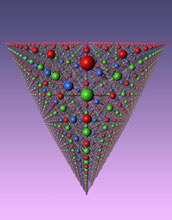Multimedia Gallery
Crystal I
Crystal I
"Crystal I," from the Gallery of Eric J. Heller. Explanation of image, as taken from Heller Gallery: In Crystal I we are looking corner-on at a small cubic sample of a perfect crystal consisting of a periodic array of three different atoms. The top layer (red) and the other two surfaces visible of Crystal I shows the orchard effect, with a much more complicated pattern looking through the bulk of the crystal, which is a three dimensional orchard. In spite of the complexity seen peering through the crystal, Crystal I is a perfectly regular array of three different atoms. This reminds us that even perfectly ordered systems may be quite complex. Note the different atoms which appear on different faces: only red atoms on the top, red and green on the right face, and all three on the left face.
Heller's work was included in the exhibit "Approaching Chaos," shown at the National Science Foundation (NSF) headquarters in Arlington, Va., July thru October 2002, as part of "The Art of Science Project." The Art of Science Project was conceived and implemented by a cross-directorate committee of NSF staff. Its purpose is to bring to NSF, original works of art that visually explore the connections between artistic and scientific expression.
This image is copyright and was included in the NSF Multimedia Gallery with permission from the owner. See "Restrictions" below regarding use of this image. [Research supported by Harvard's NSEC (NSF) grant.] (Date of Image: 2001)
Credit: Eric J. Heller, Harvard University
Special Restrictions: Copyright 2001 Eric J. Heller; not for publication without permission of author. Contact at mailto:slheller@comcast.net.
Images and other media in the National Science Foundation Multimedia Gallery are available for use in print and electronic material by NSF employees, members of the media, university staff, teachers and the general public. All media in the gallery are intended for personal, educational and nonprofit/non-commercial use only.
Images credited to the National Science Foundation, a federal agency, are in the public domain. The images were created by employees of the United States Government as part of their official duties or prepared by contractors as "works for hire" for NSF. You may freely use NSF-credited images and, at your discretion, credit NSF with a "Courtesy: National Science Foundation" notation.
Additional information about general usage can be found in Conditions.
Also Available:
Download the high-resolution JPG version of the image. (412 KB)
Use your mouse to right-click (Mac users may need to Ctrl-click) the link above and choose the option that will save the file or target to your computer.

